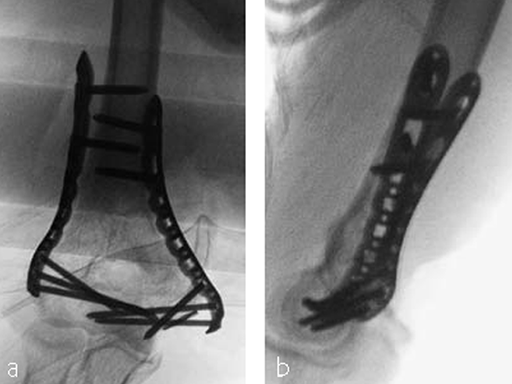
VA-LCP Elbow Plating System
Norbert Südkamp, Stefaan Nijs
The treatment of complex and/or intra-articular fractures of the elbow, when combined with poor bone quality, is a clinical challenge with a high rate of unsatisfactory results (loss of reduction, non-unions and impaired function). Significant stiffness, pain, and deformity can follow treatment of the fractures in both adults and adolescents. Prolonged immobilization usually leads to these clinical complications, as also can occur with traction. In order to overcome this, stable reduction and fixation of fractures is required so that active motion can be started early to produce the best possible results.
Founded upon the established AO principles, and based on the first generation elbow plates, the new Variable Angle LCP Elbow Plating System reduces the risk of soft tissue irritation, taking into account the poor soft tissue coverage of the elbow, by improving the plate profile, optimizing the anatomical plate contours, and enabling the screw heads to sit flush in the plate hole. The variable angle locking technology combines the simplicity of the established LCP screw insertion technique with the possibility of adapting screw angulations. Safety is enhanced during screw insertion by offering optimized redefined screw angles while allowing +/-15° off-axis angulation, if needed.
Responding to the specifics of proximal ulna fractures, the system recognizes the particular biomechanical requirements of each fracture type, offering specific implants with optimized shapes and screw configurations. The multiple distal humerus plate configurations that are provided, including parallel and perpendicular plating, address surgeon plating preferences, offering a portfolio to treat a vast array of elbow fractures.
An optimized metaphyseal plate profile, together with rounded edges and an improved anatomical plate fit, minimize the prominence of the construct without compromising stability. The 2.7 mm Variable Angle Locking Screw and a newly developed 2.7 mm Low-Profile Metaphyseal Compression Screw, an alternative to a cortex screw (non-locking) with low-profile head, assure a minimal screw-head prominence. The predefined screw angles are optimized for common fracture patterns for average anatomy. Where needed, undercuts in the metaphyseal part and recon notches enable adaptation to the plate axis to the bone-shaft axis.
The VA-LCP Elbow Plating System offers three main double-plating configurations for the distal humerus: Perpendicular; perpendicular with lateral support, and Parallel. In response to the specifics of the proximal ulna, the new system offers the Proximal Olecranon Plate, the Olecranon Plate, and the Proximal Ulna Plate, extra-articular.
Case: Elbow Surgery
Case provided by Norbert Südkamp, Freiburg, Germany
A 94-year-old man underwent surgery on his left elbow, using the VA-LCP Elbow Plating System. Plaster was used for soft tissue healing. The following images show intraoperative x-rays.
Solutions for the Elbow
Hazards and labeling
Due to varying countries’ legal and regulatory approval requirements, consult the appropriate local product labeling for approved intended use of the products described on this website. All devices on this website are approved by the AO Technical Commission. For logistical reasons, these devices may not be available in all countries worldwide at the date of publication.
Legal restrictions
This work was produced by AO Foundation, Switzerland. All rights reserved by AO Foundation. This publication, including all parts thereof, is legally protected by copyright.
Any use, exploitation or commercialization outside the narrow limits set forth by copyright legislation and the restrictions on use laid out below, without the publisher‘s consent, is illegal and liable to prosecution. This applies in particular to photostat reproduction, copying, scanning or duplication of any kind, translation, preparation of microfilms, electronic data processing, and storage such as making this publication available on Intranet or Internet.
Some of the products, names, instruments, treatments, logos, designs, etc referred to in this publication are also protected by patents, trademarks or by other intellectual property protection laws (eg, “AO” and the AO logo are subject to trademark applications/registrations) even though specific reference to this fact is not always made in the text. Therefore, the appearance of a name, instrument, etc without designation as proprietary is not to be construed as a representation by the publisher that it is in the public domain.
Restrictions on use: The rightful owner of an authorized copy of this work may use it for educational and research purposes only. Single images or illustrations may be copied for research or educational purposes only. The images or illustrations may not be altered in any way and need to carry the following statement of origin “Copyright by AO Foundation, Switzerland”.
Check www.aofoundation.org/disclaimer for more information.
If you have any comments or questions on the articles or the new devices, please do not hesitate to contact us.
“approved by AO Technical Commission” and “approved by AO”
The brands and labels “approved by AO Technical Commission” and “approved by AO”, particularly "AO" and the AO logo, are AO Foundation's intellectual property and subject to trademark applications and registrations, respectively. The use of these brands and labels is regulated by licensing agreements between AO Foundation and the producers of innovation products obliged to use such labels to declare the products as AO Technical Commission or AO Foundation approved solutions. Any unauthorized or inadequate use of these trademarks may be subject to legal action.
AO ITC Innovations Magazine
Find all issues of the AO ITC Innovations Magazine for download here.
Innovation Awards
Recognizing outstanding achievements in development and fostering excellence in surgical innovation.






